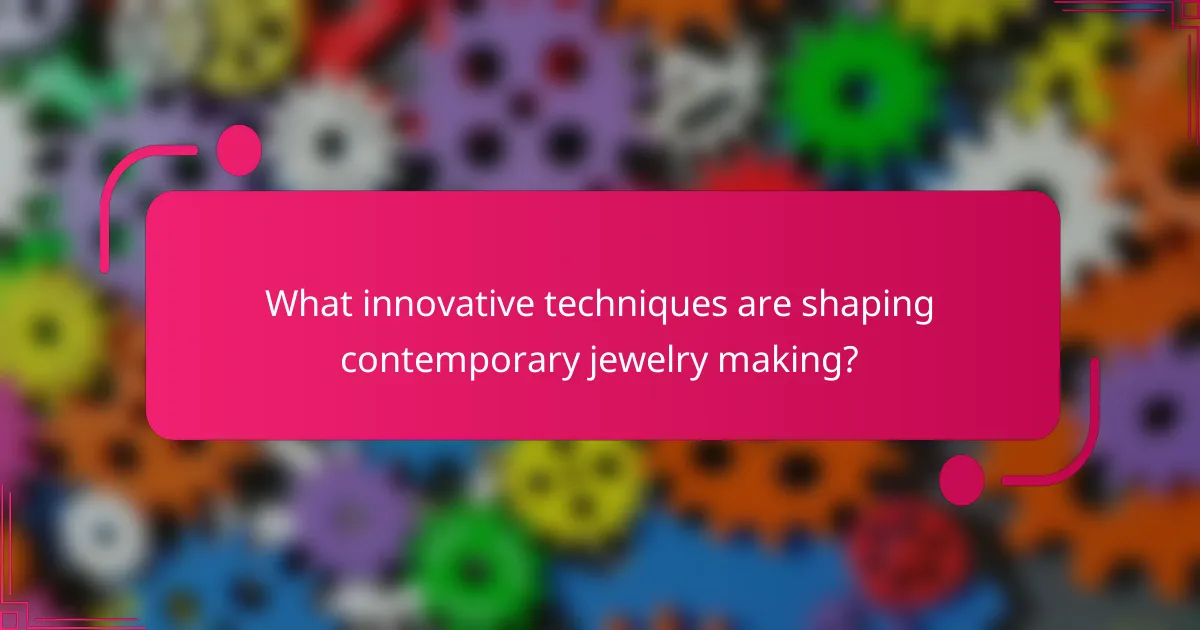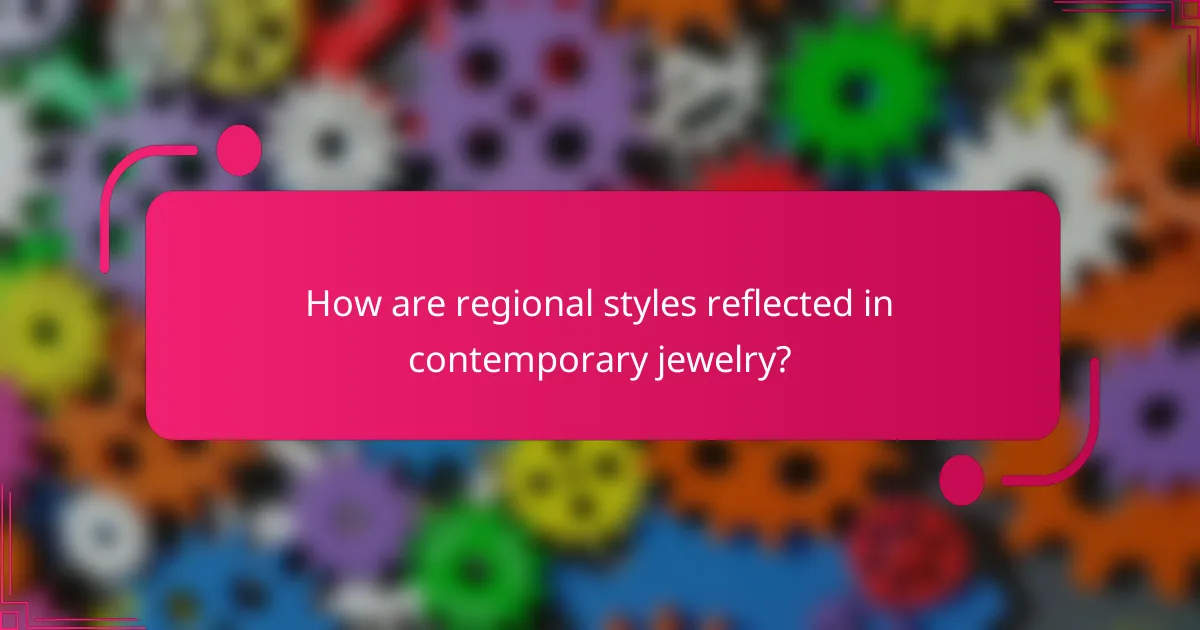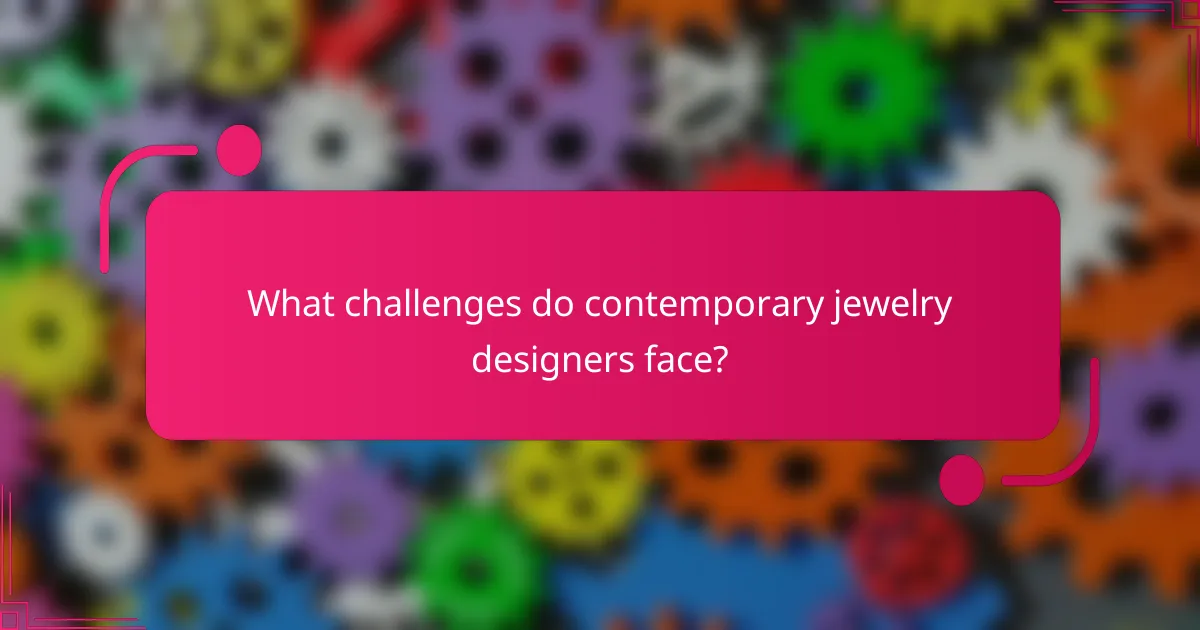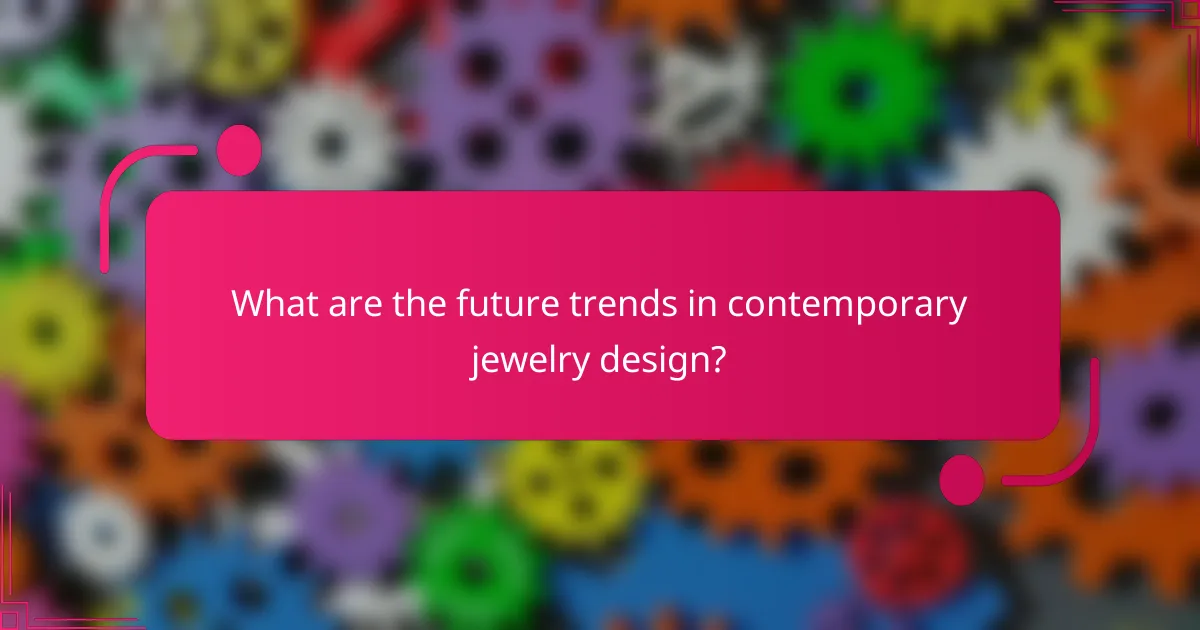Contemporary jewelry design is evolving with innovative materials and techniques that enhance artistic expression. This article explores the diverse materials used, including precious metals and alternative substances. It examines cutting-edge techniques like 3D printing and mixed media that push creative boundaries. Additionally, we will look at the artistic inspirations driving these designs and the regional styles that influence modern craftsmanship. Finally, we address the challenges designers face and the future trends shaping the industry.

What are the key materials used in contemporary jewelry design?
Contemporary jewelry design utilizes a range of materials including precious metals, gemstones, and alternative materials like resin or wood. These materials enhance the artistic expression and innovation in jewelry pieces.
Precious metals such as gold, silver, and platinum remain foundational for their durability and aesthetic appeal. Gemstones, both natural and synthetic, provide color and uniqueness to designs. Alternative materials, like recycled elements or unconventional substances, allow for sustainability and creativity, reflecting current trends in the industry.
Additionally, techniques such as 3D printing and mixed media are increasingly employed, showcasing the integration of technology in contemporary designs. This evolution in materials and methods underscores the diversity and dynamism of contemporary jewelry design.
How do different metals influence jewelry aesthetics?
Different metals significantly influence jewelry aesthetics by altering color, texture, and overall design appeal. For instance, gold offers warmth and luxury, while silver provides a cool, modern look.
The choice of metal impacts durability and maintenance as well. Platinum, known for its rarity and strength, enhances a piece’s exclusivity. In contrast, copper’s unique patina adds character over time.
Additionally, the metal’s weight contributes to the feel of the jewelry. Lighter metals like aluminum can create airy designs, whereas heavier metals like titanium offer a substantial presence.
Ultimately, the metal selection defines the emotional response and stylistic direction of contemporary jewelry, enhancing its artistic expression.
What role do gemstones play in modern jewelry creations?
Gemstones are central to modern jewelry design, enhancing aesthetic appeal and conveying personal meaning. Their unique attributes, such as color and rarity, influence design choices and craftsmanship. Designers use gemstones to create distinctive pieces that reflect individual styles and cultural significance. Additionally, advancements in techniques allow for innovative settings and combinations, further elevating the role of gemstones in contemporary jewelry.
Which sustainable materials are gaining popularity in the industry?
Sustainable materials gaining popularity in contemporary jewelry design include recycled metals, lab-grown gemstones, and biodegradable materials. These choices reduce environmental impact and appeal to eco-conscious consumers. Recycled metals, such as gold and silver, significantly lower resource extraction. Lab-grown gemstones offer ethical alternatives with similar beauty to mined stones. Biodegradable materials, like plant-based resins, provide innovative design options while minimizing waste.
How do designers incorporate unconventional materials?
Designers incorporate unconventional materials by exploring innovative textures and forms to enhance contemporary jewelry. These materials often include recycled elements, organic substances, and industrial components, which challenge traditional aesthetics. For example, using 3D-printed plastics allows for intricate designs that were previously unattainable. The integration of such materials not only reflects sustainability but also encourages unique artistic expressions.

What innovative techniques are shaping contemporary jewelry making?
Innovative techniques shaping contemporary jewelry making include 3D printing, laser cutting, and mixed media approaches. These methods enhance precision and allow intricate designs that were previously difficult to achieve. 3D printing enables customization, while laser cutting offers clean edges and complex patterns. Mixed media incorporates unconventional materials, expanding artistic expression. As a result, modern jewelry reflects diverse influences and personal narratives.
How does 3D printing revolutionize jewelry design?
3D printing revolutionizes jewelry design by enabling intricate customization and rapid prototyping. This technology allows designers to create complex geometries that traditional methods cannot achieve. As a result, unique pieces can be produced with precision and reduced waste. Additionally, 3D printing facilitates the use of diverse materials, including metals and polymers, enhancing design possibilities. This innovation empowers artisans to experiment with artistic inspirations while meeting consumer demands for personalization.
What traditional techniques are still relevant today?
Traditional techniques in jewelry design remain relevant today, as they offer unique craftsmanship and cultural significance. Techniques like hand engraving, filigree, and lost-wax casting continue to inspire contemporary artists. These methods enhance the aesthetic appeal and authenticity of modern pieces. Additionally, the use of natural materials, such as gemstones and metals, connects contemporary designs to historical practices. The blend of tradition with modern innovation creates distinctive jewelry that resonates with consumers seeking authenticity and artistry.
How do artisans blend technology with craftsmanship?
Artisans blend technology with craftsmanship by integrating digital tools into traditional design processes. This fusion enhances precision and creativity in contemporary jewelry design. For instance, computer-aided design (CAD) software allows artisans to create intricate patterns that were previously difficult to achieve by hand. Additionally, 3D printing technology enables rapid prototyping, allowing for quick adjustments and experimentation with materials. This combination of technology and craftsmanship not only streamlines production but also opens new avenues for artistic expression, ultimately enriching the jewelry-making process.

What artistic inspirations drive contemporary jewelry design?
Contemporary jewelry design is driven by diverse artistic inspirations including nature, culture, and personal experiences. These influences shape the choice of materials and techniques used by designers. For instance, organic forms often reflect natural elements, while cultural motifs can signify heritage and identity. Additionally, contemporary artists frequently incorporate innovative materials like resin and 3D-printed components, expanding traditional boundaries. This fusion of inspirations fosters unique expressions in jewelry, making it a dynamic art form.
Which cultural influences are prominent in jewelry design today?
Cultural influences in contemporary jewelry design include global traditions, art movements, and personal narratives. Designers often draw inspiration from diverse cultures, incorporating elements like symbolism and craftsmanship. For example, African tribal motifs and Japanese minimalism frequently appear in modern pieces. Additionally, the rise of sustainable practices reflects a cultural shift towards environmental consciousness, influencing material choices and design philosophies.
How do fashion trends affect jewelry aesthetics?
Fashion trends significantly influence jewelry aesthetics by dictating materials, styles, and design techniques. Current trends prioritize sustainability, leading to the use of recycled metals and ethically sourced gemstones. For example, minimalist designs are popular, emphasizing clean lines and subtle elegance. As a result, contemporary jewelry often reflects broader cultural movements, such as the rise of individual expression and the fusion of vintage and modern elements. This interplay shapes unique jewelry pieces that resonate with current consumer values and preferences.
What role does nature play in inspiring jewelry artists?
Nature plays a crucial role in inspiring jewelry artists by providing organic forms, colors, and textures. Many contemporary jewelry designs reflect natural elements, such as flowers, leaves, and landscapes. Artists often use materials like gemstones and metals that evoke the beauty of the natural world. This connection fosters creativity and innovation in their work, allowing for unique expressions of artistry. Nature’s influence can be seen in the intricate details and harmonious designs that resonate with audiences, enhancing the emotional appeal of the jewelry.

How are regional styles reflected in contemporary jewelry?
Regional styles significantly influence contemporary jewelry design through the use of traditional materials, techniques, and motifs. Artisan craftsmanship from specific regions often inspires modern designers to incorporate local materials, such as gemstones or metals, reflecting cultural heritage. For example, Native American jewelry frequently features turquoise and silver, showcasing unique patterns and craftsmanship.
Additionally, contemporary artists reinterpret historical techniques, blending them with modern aesthetics. This fusion creates distinctive pieces that resonate with both tradition and innovation. Regional motifs, such as floral patterns or geometric shapes, are reimagined in contemporary contexts, offering fresh perspectives while honoring cultural roots.
Overall, regional styles add depth and narrative to contemporary jewelry, allowing wearers to connect with diverse cultural stories through unique designs.
What unique design elements characterize North American jewelry?
North American jewelry is characterized by unique design elements that reflect cultural diversity and artistic innovation. Key features include the use of indigenous materials, such as turquoise and silver, which symbolize heritage. Techniques like handcrafting and intricate beadwork showcase skilled artistry. Contemporary influences often merge traditional motifs with modern aesthetics, creating pieces that tell stories of identity and place. Additionally, sustainable practices are increasingly valued, emphasizing eco-friendly materials and ethical sourcing.
How does European jewelry differ in technique and style?
European jewelry differs in technique and style through diverse cultural influences, craftsmanship, and material choices. Techniques such as filigree and granulation are prevalent, showcasing intricate detail. Styles vary from minimalist Scandinavian designs to ornate Mediterranean pieces. Unique attributes like the use of local gemstones further distinguish regional designs. Contemporary European jewelry often incorporates sustainable materials, reflecting a growing trend toward eco-consciousness in artistry.
Which Asian influences are evident in modern jewelry design?
Asian influences in modern jewelry design include intricate craftsmanship, symbolic motifs, and the use of natural materials. Techniques like filigree and enamel work reflect traditional Asian artistry. Additionally, gemstones such as jade and pearls are often incorporated for their cultural significance. The blending of these elements creates unique, contemporary pieces that honor heritage while appealing to modern aesthetics.

What challenges do contemporary jewelry designers face?
Contemporary jewelry designers face challenges such as material sourcing, sustainability concerns, and market competition. These issues impact creativity and profitability. Designers must navigate rising costs of ethical materials while appealing to eco-conscious consumers. Additionally, the digital marketplace intensifies competition, requiring innovative marketing strategies.
How does market competition impact design choices?
Market competition significantly influences design choices in contemporary jewelry. Designers often adapt materials and techniques to differentiate their creations and appeal to consumer preferences. As a result, they may explore innovative materials or unique artistic inspirations to stand out. For instance, increased competition can lead to the use of sustainable materials, reflecting consumer demand for eco-friendly options. This dynamic drives continuous evolution in design aesthetics and functionality, ensuring that jewelry remains relevant and desirable in a crowded marketplace.
What are the common pitfalls in sustainable jewelry production?
Common pitfalls in sustainable jewelry production include sourcing conflict minerals, neglecting ethical labor practices, and using non-eco-friendly materials. These issues undermine the integrity of sustainable design. Additionally, lack of transparency in supply chains can mislead consumers about sustainability claims. Brands must prioritize responsible sourcing and fair labor to avoid these pitfalls.
How do designers navigate consumer trends and demands?
Designers navigate consumer trends by closely observing market preferences and adapting their creations accordingly. They analyze social media, fashion shows, and consumer feedback to identify emerging styles. Collaboration with influencers and artists helps them stay relevant. Unique materials and innovative techniques are used to meet the evolving demands of consumers. As a result, contemporary jewelry design reflects personal expression and sustainability, aligning with consumer values.

What are the future trends in contemporary jewelry design?
Future trends in contemporary jewelry design focus on sustainability, technology integration, and personalization. Designers increasingly use recycled materials and ethical sourcing to appeal to eco-conscious consumers. Innovative techniques, such as 3D printing, allow for unique designs that push creative boundaries. Additionally, personalization through custom designs and wearable technology is gaining traction, making jewelry more meaningful and interactive. These trends reflect a shift towards responsible consumption and individual expression in the jewelry market.
How is technology expected to influence future designs?
Technology is expected to significantly enhance contemporary jewelry design by introducing innovative materials and techniques. Advanced tools like 3D printing enable intricate designs that were previously impossible. Smart technologies integrate functionality, allowing jewelry to monitor health or connect to devices. Sustainable materials, such as lab-grown gems, are gaining popularity, reflecting environmental concerns. Customization tools empower consumers to create unique pieces, fostering personal expression. As a result, the future of jewelry design will be marked by creativity, sustainability, and interactivity.
Which emerging materials could reshape the industry?
Innovative materials like bio-resins, lab-grown gemstones, and recycled metals are emerging to reshape contemporary jewelry design. These materials enhance sustainability while offering unique aesthetic qualities. Bio-resins provide versatility in form and color, lab-grown gemstones ensure ethical sourcing, and recycled metals reduce environmental impact. As a result, the industry is transitioning towards more responsible and creative practices.
What role will personalization play in future jewelry trends?
Personalization will significantly shape future jewelry trends by enhancing customer engagement and satisfaction. As consumers seek unique expressions of identity, brands will increasingly offer customizable options. This trend reflects a unique attribute of contemporary jewelry design, allowing for tailored pieces that resonate personally with wearers. Personalized jewelry can include engraved messages, birthstones, or bespoke designs, creating deeper emotional connections. As technology advances, tools for customization will become more accessible, driving innovation in materials and techniques used in contemporary jewelry design.
What best practices should designers adopt for success in 2025?
Designers should adopt sustainable materials, innovative techniques, and diverse artistic inspirations for success in 2025. Emphasizing eco-friendly practices will resonate with consumers increasingly focused on environmental impact. Incorporating technology, such as 3D printing and augmented reality, can enhance design capabilities and customer engagement. Additionally, drawing inspiration from various cultures and art movements will foster unique and appealing collections. Collaborations with artists from different disciplines can also infuse fresh perspectives into jewelry design.
